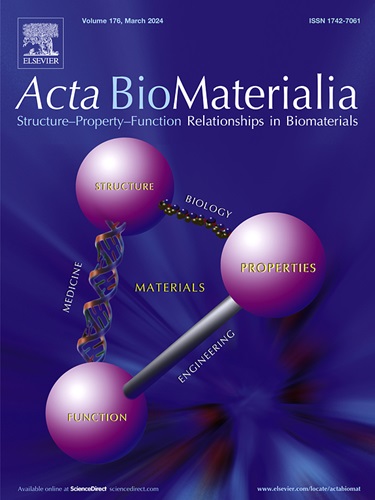A bacteria-responsive nanoplatform with biofilm dispersion and ROS scavenging for the healing of infected diabetic wounds
IF 9.4
1区 医学
Q1 ENGINEERING, BIOMEDICAL
引用次数: 0
Abstract
Delayed wound healing in patients with diabetes remains a major health challenge worldwide. Uncontrolled bacterial infection leads to excessive production of reactive oxygen species (ROS) and persistent inflammatory responses, which seriously hinder conventional physiological healing processes after injury. Biofilms, as protective barriers for bacteria, pose a critical obstacle to effective bacterial eradication. Herein, an innovative therapeutic nanoplatform with in situ antibacterial and antioxidant properties is developed for enhancing infected diabetic wound healing. The enrichment of phenylboronic acid (PBA) moieties on the nanoplatform enhances biofilm penetration, actively anchors and aggregates the enclosed bacteria through the "multivalent effect", with an anchoring efficiency as high as 80 %. Additionally, glycine moieties on the nanoplatform ensure spatial extensibility by charge repulsion, enabling targeted antibiotic release around bacteria. This precise antibacterial effect increases the bactericidal activities of the nanoplatform against S. aureus or P. aeruginosa by 25 % and 22 % respectively, effectively eliminating the bacteria and dispersing the biofilms. Furthermore, 3,4-dihydropyrimidin-2(1H)-one (DHPM) moieties act as ROS scavengers that alleviate oxidative stress and inflammatory responses, promoting tissue repair progression into the proliferative phase characterized by increased extracellular matrix deposition, angiogenesis, and granulation tissue formation, ultimately accelerating diabetic wound healing. Overall, this work presents an innovative bacterial response strategy for achieving in situ antibacterial and antioxidant effects in infected tissues and provides a promising therapeutic approach for treating infected diabetic wounds.
Statement of significance
Infected diabetic wound management remains a major world health issue. Severe bacterial infection leads to excessive oxidative stress and persistent inflammatory response, which seriously hinders the wound healing process. As a protective barrier for bacteria, biofilms are a key obstacle to effective bacterial clearance. This study provides a bacteria-responsive nanoplatform for the healing of infected diabetic wounds. The nanoplatform not only exhibits improved biofilm penetration but also actively anchors the enclosed bacteria and enables targeted antibiotic release to disperse the biofilm. The DHPM moieties of the nanoplatform act as ROS scavengers which could alleviate inflammatory responses, promote tissue repair progression into the proliferative phase, and ultimately accelerate diabetic wound repair.

具有生物膜分散和活性氧清除功能的细菌响应纳米平台用于糖尿病感染伤口的愈合。
糖尿病患者伤口愈合延迟仍然是世界范围内的一个主要健康挑战。不受控制的细菌感染会导致活性氧(ROS)的过量产生和持续的炎症反应,严重阻碍损伤后的常规生理愈合过程。生物膜作为细菌的保护屏障,是有效消灭细菌的关键障碍。本文开发了一种具有原位抗菌和抗氧化特性的创新治疗纳米平台,用于促进感染糖尿病伤口愈合。苯基硼酸(PBA)在纳米平台上的富集增强了生物膜的穿透性,通过“多价效应”积极地锚定和聚集被封闭的细菌,锚定效率高达80%。此外,纳米平台上的甘氨酸部分通过电荷排斥确保空间可扩展性,从而使抗生素在细菌周围靶向释放。这种精确的抗菌效果使纳米平台对金黄色葡萄球菌和铜绿假单胞菌的杀菌活性分别提高了25%和22%,有效地消除了细菌并分散了生物膜。此外,3,4-二氢嘧啶-2(1H)- 1 (DHPM)部分作为ROS清除剂,减轻氧化应激和炎症反应,促进组织修复进程进入增生期,其特征是细胞外基质沉积、血管生成和肉芽组织形成增加,最终加速糖尿病伤口愈合。总的来说,这项工作提出了一种创新的细菌反应策略,可以在感染组织中实现原位抗菌和抗氧化作用,并为治疗感染的糖尿病伤口提供了一种有前途的治疗方法。意义说明:*糖尿病感染伤口管理仍然是一个重大的世界卫生问题。严重的细菌感染会导致过度的氧化应激和持续的炎症反应,严重阻碍伤口愈合过程。作为细菌的保护屏障,生物膜是有效清除细菌的关键障碍。该研究为糖尿病感染伤口的愈合提供了一种细菌反应纳米平台。纳米平台不仅表现出更好的生物膜穿透能力,而且还能主动锚定被封闭的细菌,并使抗生素靶向释放以分散生物膜。纳米平台的DHPM部分作为活性氧清除剂,可以减轻炎症反应,促进组织修复进展到增殖期,最终加速糖尿病伤口修复。
本文章由计算机程序翻译,如有差异,请以英文原文为准。
求助全文
约1分钟内获得全文
求助全文
来源期刊

Acta Biomaterialia
工程技术-材料科学:生物材料
CiteScore
16.80
自引率
3.10%
发文量
776
审稿时长
30 days
期刊介绍:
Acta Biomaterialia is a monthly peer-reviewed scientific journal published by Elsevier. The journal was established in January 2005. The editor-in-chief is W.R. Wagner (University of Pittsburgh). The journal covers research in biomaterials science, including the interrelationship of biomaterial structure and function from macroscale to nanoscale. Topical coverage includes biomedical and biocompatible materials.
文献相关原料
公司名称
产品信息
索莱宝
total antioxidant capacity (T-AOC) Kit
 求助内容:
求助内容: 应助结果提醒方式:
应助结果提醒方式:


